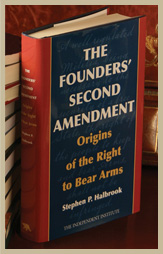Preface

Reprinted from the Book:
The Founders’ Second Amendment:
Origins of the Rights to Bear Arms
By Stephen P. Halbrook, Ph.D., J.D.
Published by Ivan R. Dee, Publisher, for The Independent Institute
Copyright © 2008. All Rights Reserved.
This is the first book-length account of the nature of the Second Amendment right of the people to keep and bear arms during the generation of the Founders of the American republic. This period spans from the last years of British rule and the American Revolution through the adoption of the Constitution and Bill of Rights and the passing away of the Founders’ generation. Those years began in 1768, when Redcoats first occupied Boston, and ended when Thomas Jefferson and John Adams died on July 4, 1826.
“Marshaling an impressive array of historical evidence,” writes Supreme Court Justice Clarence Thomas, “a growing body of scholarly commentary indicates that the ‘right to keep and bear arms’ is, as the Amendment’s text suggests, a personal right.”1 He cited two books, Joyce Lee Malcolm’s To Keep and Bear Arms: The Origins of an Anglo-American Right—the preeminent study of the English beginnings of the right, and this author’s That Every Man Be Armed: The Evolution of a Constitutional Right—which traces the right from its Greco-Roman origins through modern American jurisprudence.
Few contributions to Second Amendment scholarship existed until the 1980s. Today, journal articles on the amendment abound.2 This author also published books on how the right to keep and bear arms was perceived in the original thirteen states3 and on the treatment of this right during Reconstruction as a civil right won by freedmen.4
Yet perhaps the most important piece of the puzzle is missing—a truly comprehensive treatment of the views of the Founders, from the pre-Revolutionary days through the passing of that generation. This book seeks to fill that void.5
It would be difficult to acknowledge every person who assisted in preparation of this work. The author, while solely responsible for any deficiencies, thanks the many scholars over the years who, in one way or another, contributed toward a critique of the theses of this book. Special thanks for their critical perusal of the manuscript are due to Forrest McDonald, Distinguished University Professor, University of Alabama; Joyce Lee Malcolm, Professor of Law, George Mason University; Nelson Lund, Patrick Henry Professor of Constitutional Law and the Second Amendment, George Mason University; and Alexander Tabarrok, Research Director, The Independent Institute. There were several anonymous peer reviewers whose challenges, on points great and small, invariably made this a better book. Also helpful, in many contexts, were the contributions of William Van Alstyne, David Kopel, Robert Dowlet, Richard Gardiner, Don Kates, David Caplan, George Knight, Eugene Volokh, Akhil Amar, Robert Cottrol, and Glenn Reynolds.
Appreciation must also be expressed to those who pored through obscure eighteenth-century documents or otherwise assisted in the research for this book, including Heather Barry, David Fischer, Patrick Halbrook, Oliver Harriehausen, Jordan Jackson, and Suzanne Anglewicz. Editorial assistance was provided by Lisa Halbrook and Jennifer Gordon. For preparation of the manuscript, the assistance of Gail Saari, Megan Whitson, and Alyson Nolan must be acknowledged. Special thanks are due to David J. Theroux, President of The Independent Institute, for tirelessly sponsoring and moving the publication of this book forward.
Notes:
1. Printz v. United States, 521 U.S. 898, 939 n.2 (1997) (Thomas, J., concurring), citing in part Joyce Lee Malcolm, To Keep and Bear Arms: The Origins of an Anglo-American Right (Cambridge: Harvard University Press, 1994), 162; Stephen P. Halbrook, That Every Man Be Armed: The Evolution of a Constitutional Right (Albuquerque: University of New Mexico Press, 1984; reprinted, 1994, 2000 by The Independent Institute, Oakland, Calif.). See also William Van Alstyne, The Second Amendment and the Personal Right to Arms, 43 Duke L. J. 1236 (1994); Akhil Reed Amar, The Bill of Rights and the Fourteenth Amendment, 101 Yale L. J. 1193 (1992); Robert J. Cottrol & Raymond T. Diamond, The Second Amendment: Toward an Afro-Americanist Reconsideration, 80 Geo. L. J. 309 (1991); Sanford Levinson, The Embarrassing Second Amendment, 99 Yale L. J. 637 (1989); Don Kates, Handgun Prohibition and the Original Meaning of the Second Amendment, 82 Mich. L. Rev. 204 (1983).
2. See, e.g., the scores of articles cited in Lawrence Tribe, American Constitutional Law (New York: Foundation Press, 3rd ed., 2000), 897-98 n.211; David B. Kopel, The Second Amendment in the Nineteenth Century, BYU L. Rev., No. 4, 1359, 1362-65 (1998). Many more have been published since then.
3. Stephen P. Halbrook, A Right to Bear Arms: State and Federal Bills of Rights and Constitutional
Guarantees (Westport, Conn.: Greenwood Press, 1989).
4. Stephen P. Halbrook, Freedmen, the Fourteenth Amendment, and the Right to Bear Arms,
1866–1876 (Westport, Conn.: Praeger Publishers, 1998).
5. To be sure, there are many noteworthy contributions to the subject. See Robert H. Churchill, Gun Regulation, the Police Power, and the Right to Keep Arms in Early America: The Legal Context of the Second Amendment, 25 Law & History Rev. 139 (2007) (with critical comments by David Konig, William Merkel, and Saul Cornell); Robert E. Shalhope, The Armed Citizen in the Early Republic, 49 Law and Contemp. Probs. 125 (1986); Nelson Lund, The Second Amendment, Political Liberty, and the Right to Self-Preservation, 39 Ala. L. Rev. 130 (1987); Lawrence D. Cress, An Armed Community: The Origin and Meaning of the Right to Bear Arms, 71 Jour. of American History 22 (1984).








